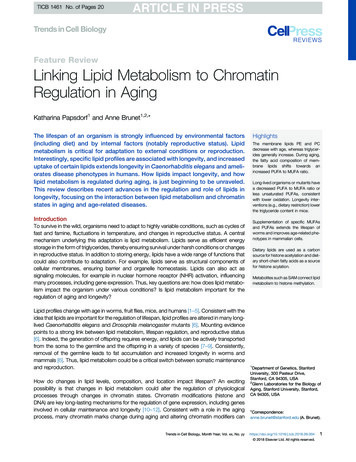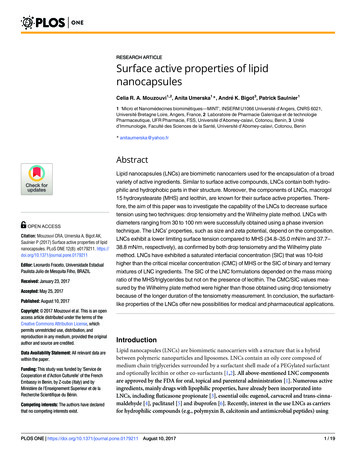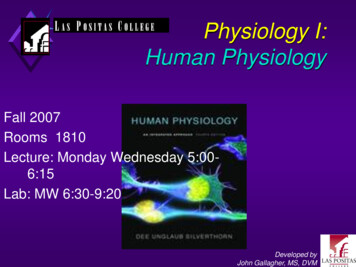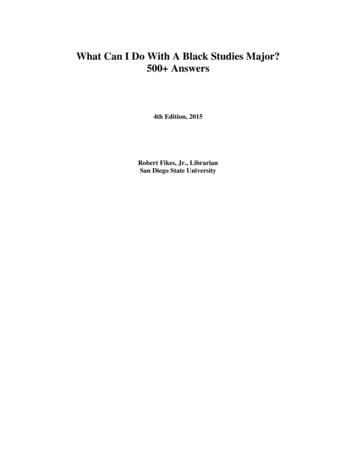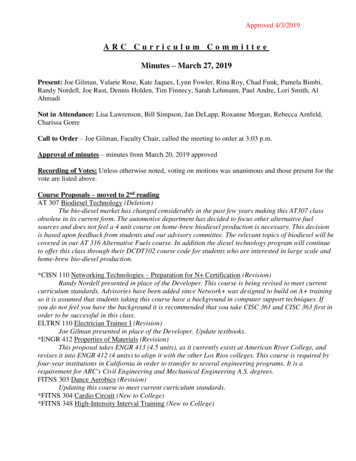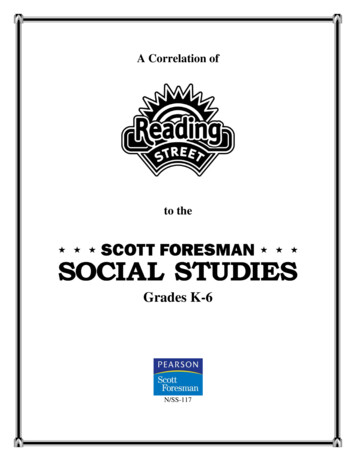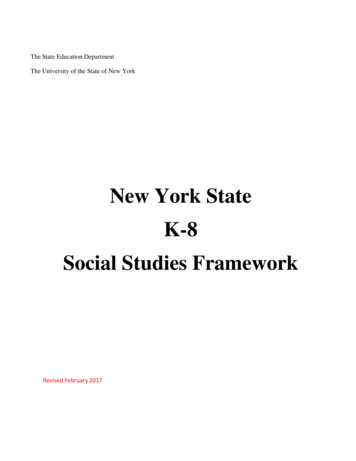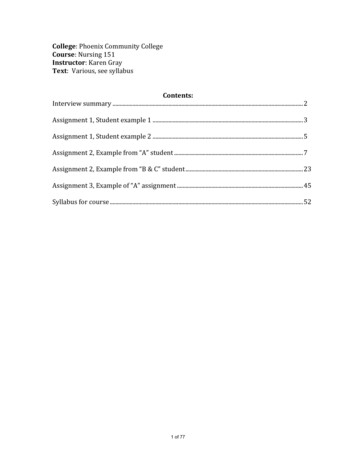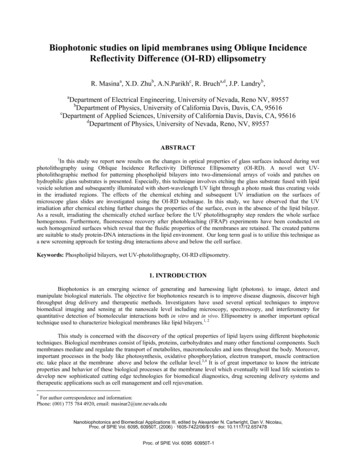
Transcription
Biophotonic studies on lipid membranes using Oblique IncidenceReflectivity Difference (OI-RD) ellipsometryR. Masinaa, X.D. Zhub, A.N.Parikhc, R. Brucha,d, J.P. Landryb,aDepartment of Electrical Engineering, University of Nevada, Reno NV, 89557bDepartment of Physics, University of California Davis, Davis, CA, 95616cDepartment of Applied Sciences, University of California Davis, Davis, CA, 95616dDepartment of Physics, University of Nevada, Reno, NV, 89557ABSTRACT1In this study we report new results on the changes in optical properties of glass surfaces induced during wetphotolithography using Oblique Incidence Reflectivity Difference Ellipsometry (OI-RD). A novel wet UVphotolithographic method for patterning phospholipid bilayers into two-dimensional arrays of voids and patches onhydrophilic glass substrates is presented. Especially, this technique involves etching the glass substrate fused with lipidvesicle solution and subsequently illuminated with short-wavelength UV light through a photo mask thus creating voidsin the irradiated regions. The effects of the chemical etching and subsequent UV irradiation on the surfaces ofmicroscope glass slides are investigated using the OI-RD technique. In this study, we have observed that the UVirradiation after chemical etching further changes the properties of the surface, even in the absence of the lipid bilayer.As a result, irradiating the chemically etched surface before the UV photolithography step renders the whole surfacehomogenous. Furthermore, fluorescence recovery after photobleaching (FRAP) experiments have been conducted onsuch homogenized surfaces which reveal that the fluidic properties of the membranes are retained. The created patternsare suitable to study protein-DNA interactions in the lipid environment. Our long term goal is to utilize this technique asa new screening approach for testing drug interactions above and below the cell surface.Keywords: Phospholipid bilayers, wet UV-photolithography, OI-RD ellipsometry.1. INTRODUCTIONBiophotonics is an emerging science of generating and harnessing light (photons), to image, detect andmanipulate biological materials. The objective for biophotonics research is to improve disease diagnosis, discover highthroughput drug delivery and therapeutic methods. Investigators have used several optical techniques to improvebiomedical imaging and sensing at the nanoscale level including microscopy, spectroscopy, and interferometry forquantitative detection of biomolecular interactions both in vitro and in vivo. Ellipsometry is another important opticaltechnique used to characterize biological membranes like lipid bilayers.1, 2This study is concerned with the discovery of the optical properties of lipid layers using different biophotonictechniques. Biological membranes consist of lipids, proteins, carbohydrates and many other functional components. Suchmembranes mediate and regulate the transport of metabolites, macromolecules and ions throughout the body. Moreover,important processes in the body like photosynthesis, oxidative phosphorylation, electron transport, muscle contractionetc. take place at the membrane above and below the cellular level.3,4 It is of great importance to know the intricateproperties and behavior of these biological processes at the membrane level which eventually will lead life scientists todevelop new sophisticated cutting edge technologies for biomedical diagnostics, drug screening delivery systems andtherapeutic applications such as cell management and cell rejuvenation.*For author correspondence and information:Phone: (001) 775 784 4920, email: masinar2@unr.nevada.eduNanobiophotonics and Biomedical Applications III, edited by Alexander N. Cartwright, Dan V. Nicolau,Proc. of SPIE Vol. 6095, 60950T, (2006) · 1605-7422/06/ 15 · doi: 10.1117/12.657478Proc. of SPIE Vol. 6095 60950T-1
In order to better understand the vital processes that take place at the membrane level inside the animal andhuman body, it is a great advantage to start testing artificially fabricated lipid membranes and then introducing additionalfunctional components like proteins and DNA to test the properties of these functional components and their interactionswith the lipid membrane. Our research group at the Physics Department, University of Nevada Reno (UNR) andNanolife Inc, Reno, NV collaborates with the University of California Davis (UCD) and the National ScienceFoundation (NSF) Center for Biophotonics Science and Technology (CBST) to develop new nano-biotechnologymethods to unravel the functionality of these lipid membranes and their conformational components. Especially, usingphotolithographic techniques, we can study the physical, chemical and biological functions of lipid membranes whichmay lead to new high throughput approaches in sensor microarrays, genomics, drug screening and proteomics.Furthermore, this strategy could be used in wet environments in order to understand, emulate, pattern, and determinespecific functional mechanisms of cell membranes.A special kind of label-free ellipsometric technique called Oblique Incidence Reflectivity Difference (OI-RD)ellipsometry1,5 is used for these studies. By means of OI-RD ellipsometry, an important optical change is observed,which is not detectable by the more conventional fluorescence microscopic techniques. This paper reports the details ofthe optical changes detected by the OI-RD method. Furthermore a novel cleaning approach is presented. Following thisnew technique, the surface is rendered homogenous which is used for exploration of further biomolecular interactions inthe lipid environment.2. WET UV-PHOTOLITHOGRAPHY OF LIPID BILAYERSfl7JIa-U'I-14-I.0)-IC—0C:1 Cs 9JIn this section, a wet photolithographic technique for micropatterning of fluid phospholipids bilayers ispresented in which spatially directed illumination with deep-ultraviolet (UV) radiation is applied2. The process of usingUV/Ozone light for the wet photolithography process to create voids is elucidated in Fig 1. These voids can be refilledwith lipid solution of the same kind or with a different kind and with many functional components like proteins,carbohydrates, cholesterol, DNA etc, thereby providing a means for probing two dimensional (2D) reaction-diffusionprocesses, changing membrane compositions, and designing functional membrane arrays.Fig. 1: The process of UV/Ozone degradation of the lipid bilayer creating voids.As illustrated in Fig. 1, first the glass substrate is chemically etched by immersing the substrate in a mixture of 4parts concentrated sulfuric acid (H2SO4) and 1 part hydrogen Peroxide (H2O2) at 100 C to remove organic contaminantsand expose hydrophilic groups on the surface. Then, phospholipids are fused on the etched surface to form bilayers usingProc. of SPIE Vol. 6095 60950T-2
the method of unilamellar lipid vesicle fusion. The lipids used for these studies are Texas Red (TR) labeled P1Palmitoyl-2-Oleoyl-Sn-Glycero-3-Phosphocholine (POPC) from Avanti Polar Lipids, Inc, Alabaster, AL.When UV light is incident on the lipid bilayers at 184 nm wavelength, ozone gas is produced which penetratesthrough the quartz part of the photomask degrading the lipid bilayers thus creating voids. Exposure to UV light createsvoids uniformly throughout the lipid membrane. Then the patterned sample is imaged under a fluorescence microscopeand the fluidic properties of the lipid membrane are verified. Two typically patterned lipid bilayer samples imaged undera fluorescence microscope are shown in Fig 2.250 urn(a)(b)Fig. 2: (a) Shows the image of a TR labeled POPC lipid sample patterned using a photomask which has regular patterns of dimensions250 nm. (b) Is the image of a TR labeled POPC sample patterned using a photomask with 100 nm patterns.The grey background observed from Fig 2 corresponds to the fabricated lipid bilayer on glass substrate and thedark black squares seen are the voids created due to the exposure to UV/Ozone light. In order to monitor the biochemicalinteractions at the membrane level, we have employed a special type of ellipsometric technique called OI-RD.3. OBLIQUE INCIDENCE REFLECTIVITY DIFFERENCE (OI-RD) ELLIPSOMETRICTECHNIQUEThe OI-RD technique1 measures the optical properties of a thin film on surfaces. The OI-RD ellipsometricmethod is a label-free technique which has the ability to detect biochemical interactions of protein molecules and DNAwithout the influence of fluorescent labeling agents. It can also be used to detect several changes in the surface propertiesof the substrate which are entailed in the results and discussions section of this report.Zhu et al 5 studied the application of OI-RD ellipsometry for the detection and imaging of micro arrays on glasssubstrates. This work extends these studies using the OI-RD approach to image artificially fabricated lipid bilayers onsolid glass slides. The experimental setup of the OI-RD microscope is shown in Fig 3. At oblique incidence, thereflectivities for p- and s- polarized light can change in response to the surface properties of the material. If rp0 and rs0 arethe reflectivities from the bare substrate, and rp and rs the reflectivities from the surface covered with the lipid bilayer,respectively, then the differences p and s are defined in Eq (1) and Eq (2) as follows p s ( rp rp 0 )rp 0( rs rs 0 )rs 0Proc. of SPIE Vol. 6095 60950T-3(1)(2)
Since the thickness d of the lipid membrane is much less than the wavelength λ of the incident light, the OI-RDtechnique enables direct measurements of the real and imaginary parts of { p - s} [2]. The factor { p - s} is called thereflectivity latorPhaseShifterSubstrateReaction ChamberPatterned LipidmembraneWaterFig. 3: Setup of an (OI-RD) ellipsometerAs shown in Fig. 3, a polarized He-Ne laser beam with λ 632 nm passes through a polarization modulator,which, causes the output beam to oscillate between p- and s- polarization states. The polarization modulator is a photoelastic modulator with modulation frequency Ω 50 kHz, maximum retardation of 180 with its modulation axis at 45 relative to p-polarization. The polarization-modulated beam is then passed through a phase shifter which introduces anadjustable phase Φ0 between the s- and p- polarized components. A quarter wave plate (quartz) is used as a phase shifterfor this setup. The principal axes (X and Y) of the quarter wave plate are rotated manually with respect to the ‘s’ and ‘p’polarization states to cause a shift in phase angle. The resultant beam is focused on the lipid membrane containing thesurface at an angle of incidence θ (equal to 52 ). After reflection and recollimation, the beam passes through an analyzerand the intensity of the transmitted beam IR(t) is detected with a photodiode and is Fourier analyzed with digital lock-inamplifiers. The first and second harmonic amplitudes of IR(t), I(Ω) and I(2Ω) are detected neglecting the higherharmonics.Initially, the sample is positioned such that the laser beam reflects from the substrate without lipid bilayers. Theangles of the analyzer and the quarter wave plate are manually adjusted such that I(Ω) and I(2Ω) are zeroed at thisposition. During the subsequent scan over regions of the surface with artificially fabricated lipid bilayers, the parametersI(Ω) Im{ p - s} and I(Ω) { p - s} are measured. In this present study, only Im{ p - s} is recorded. The glasssubstrate was used as a window for the liquid cell and the laser beam is reflected from the back surface of the substrate.The substrate and the membrane are always immersed in water to maintain the diffusion properties of lipid membranes.Images were acquired by focusing the laser beam to a 3 µm spot size and subsequently scanned over an X-Y patternunderneath the fixed optics. It has been shown 6 that the { p - s} is directly proportional to the thickness of the film (d)and is given by Eq.3:1 ( ε ε )( ε ε ) d 4πε s 2 ε 0 sin 2 θ cos θsd0 d p – s -i 22εd λ ( ε 0 ε s )( ε 0 cos θ ε s sin θ Proc. of SPIE Vol. 6095 60950T-4(3)
ε s and ε d are the optical dielectric constants for thewavelength λ . At the He-Ne laser wavelength of 632 nm,Here θ is the angle of the back surface reflection, while ε 0 ,ambient, substrate and lipid membrane respectively at theε 0 1.77 (water), ε s 2.28 (glass) and ε d 2.13 (lipid), and the reflectivity difference { p - s} is determined as 5.27 10-3 where the thickness d is calculated to be 6 nm.4. EXPERIMENTAL RESULTS AND DISCUSSIONSIn this section, first the OI-RD image of a Texas Red labeled POPC sample is presented in Fig 4. In addition, asubstrate imaged without lipid fusion is shown for comparison in Fig. 5. Thus, the optical changes detected are describedand a novel cleaning approach for glass surfaces is presented. Furthermore, the verification of the cleaning technique isprovided by fluorescence recovery after photobleaching (FRAP) experiments.4.1 OI-RD Image of a Lipid SampleA Corning glass slide made of silica with dimensions 1 " (width) 3 " (length) 2.5 mm (thick) is etched and isfused with freshly extruded lipid vesicle solution. It takes approximately two minutes for the lipid bilayers to fuse ontothe hydrophilic glass substrate. Then the lipid fused substrate is subjected to Ultraviolet/ozone (UV/O) light through aphotomask to create two dimensional patterns on the fabricated lipid bilayer (as explained in Section 2 of this report).The resulting sample is carefully transferred to a Petri dish under water and imaged under a fluorescence microscope tocheck the quality of the patterns obtained and to verify the fluidic properties of the patterned lipid membrane. The samesample is transferred to the flow cell under water to be scanned with the OI-RD ellipsometer. Fig. 4 shows a typical OIRD scan of a lipid fused .OE 0-5.OE-4-l.OE-3-l .5E-3-2.OE-3-2.5E-3-3.OE-3-3.7E-3250030003500Fig. 4: OI-RD image of a lipid sample4.2 Comparison of OI-RD Samples with and without lipidThe OI-RD image of a characteristic sample without lipid fusion is displayed in Fig. 5 (b). Moreover, the OIRD image of a chemically etched glass substrate with lipid solution fused to it is indicated in Fig. 5 (a) for comparison.The glass substrate is etched and is directly illuminated by UV/Ozone light through a photo mask. Surprisingly, the OIRD ellipsometer revealed the presence of patterns even in the absence of a lipid bilayer. These patterns were not detectedso far by the conventional fluorescence microscopic technique.Fig 5 elucidates a few important observations. Both (a) and (b) are samples that are cleaned using the samecleaning protocol under the same existing conditions. But, it is impossible to differentiate them since both reveal theProc. of SPIE Vol. 6095 60950T-5
presence of regular patterns. Also, the reflectivity difference ( p - s) measured for the sample in which lipid bilayers areinvolved is of comparable size when compared to the reflectivity difference of the sample without lipid.(a)(b)Fig. 5: OI-RD images of 2 different samples (a) with lipid and (b) without lipidIn this way, it is very difficult to quantitatively distinguish between lipid patterning (patterns caused due tolipid) and substrate patterning (patterns caused due to surface imperfections). Furthermore, if backfilling of the voids(see black dark squares on the image) with a different kind of lipid is desired, the changes obtained with the new lipid aredifferent from the original membrane. Hence, further experiments were conducted in this direction to circumvent theseproblems and homogenize the surface.4.3 Homogenizing the surfaceIn our optical studies of lipid membranes on glass substrates, it was inferred that surface contaminants andinhomogeneities may cause the unwanted patterns which complicate further experiments in the lipid environment.Therefore, a new technique to homogenize the glass surface was investigated and the method is described as follows.A fresh glass substrate is chemically etched and is exposed to UV/Ozone light in water for 19 minutes. It is tonote that the glass substrate is exposed to UV/Ozone light without fusing lipid vesicles on it. The idea here is to incidentUV/Ozone light directly on the glass substrate to check whether it could remove the surface contaminants. The glasssubstrate is now placed on a photo mask and is subjected to UV/Ozone light in water once again for the same period oftime.Fig. 6: Image of the homogenized substrateProc. of SPIE Vol. 6095 60950T-6
In short, the etched glass substrate is exposed to UV/Ozone light two times, once without the photomask, andonce with the photomask. After subsequent exposures to UV/O light, the substrate is transferred to the flowcell underwater and OI-RD ellipsometric measurements are performed shown in Fig 6. The obtained image shown in Fig. 6 clearlyshows no presence of any patterns. This indicates that when the etched substrate is subjected to UV/Ozone light for 19minutes in a wet environment before the wet photolithography process, the surface becomes homogenous. Theexperiment was repeated three times to elucidate the consistency of the result obtained. The OI-RD image clearlyexhibits that the surface properties of the irradiated squares remained the same as those of unirradiated regions. This is anindication that the surface has been rendered uniform.4.4 Verification of the technique by Fluorescence experiments:It has been previously shown that lipids fuse very well on chemically etched surfaces. Fluorescence recoveryafter photobleaching (FRAP) experiments were conducted on the homogenized surface cleaned by our new approach toverify that the properties of the lipid membranes are not affected.Now, a new glass slide was homogenized using our novel cleaning procedure. The glass substrate was thenfused with lipid vesicle solution and is subjected to UV/Ozone light through a photo mask. The patterned (array of voidsand patches) lipid bilayer on the substrate is transferred to a clean Petri dish filled with water for fluorescence imaging.The fluorescence images shown in Fig.7 indicate important results mentioned as follows.(a)(b)Fig. 7: (a) Typical fluorescence image of a photo bleached spot on the lipid bilayer (b) image of the spot disappearing after 3 minutesFirstly, the lipid vesicles fused perfectly on the substrate cleaned by our technique. Secondly, there wereexcellent patterns obtained after the wet photolithography process. These inferences proved that the cleaning approachfollowed did not hamper the quality of the patterns. Furthermore, FRAP experiments on this sample proved that thefluidic properties of the lipid membrane are retained. Here, the lipid membrane is photo bleached at a particular spot andallowed to recover. If the photo bleached spot disappears in due course of time (2 or 3 min), it indicates that themembrane still possesses its fluidic properties. If not, it can be inferred that the membrane has lost its diffusioncapabilities. As shown in Fig. 7, the bleached spot disappeared after 3 minutes indicating that the lipid bilayer is fluid.4.5 OI-RD results of lipids fused to a particular section of the substrateIn order to clearly differentiate between membrane patterning (patterning of the lipid membrane) and substratepatterning, a new strategy has been employed to quantitatively distinguish the surfaces with and without lipid. Lipids arefused to a certain portion of the entire glass slide on a homogenized glass substrate. A cover slip (1" 1 " 1 mm) isused to separate the bare substrate from the lipid fused substrate. The idea here is to fuse lipids only onto a particularregion of the whole sample and track the edge of the lipid bilayer in a fluorescence microscope and the OI-RDellipsometer to compare both results. Fig. 8 provides a comparison of fluorescence microscope and OI-RD ellipsometryimages obtained for the same sample while tracking the edge of the lipid fused substrate.Proc. of SPIE Vol. 6095 60950T-7
Fig. 8 (a), (b), (c), (d), (e) represent the fluorescence microscope images of the edge and (P) represents the correspondingOI-RD results.K!!!!bP5I P itb[acdeFig. 8 (a),(b),(c),(d) are the fluorescence microscopy images of a TR-POPC lipid sample with track of its edge. (P) Shows thecorresponding OI-RD image of the edge.It is evident from Figure 8 (P), that there is no substrate patterning present thus confirming once again that thesurface was rendered homogenous. This novel developed technique is very advantageous for studying the biomolecularinteractions of different functional components with the lipid membrane at particular locations of the membrane. Sincethe voids (dark squares) can be tracked from edge to edge using a fluorescence microscope and OI-RD ellipsometer, theexact location where biomolecular interactions occur can be quantitatively monitored with precise control.5. CONCLUSIONS AND FUTURE DIRECTIONSIn conclusion, we have applied the Oblique Incidence Reflectivity Difference (OI-RD) ellipsometric technique tomonitor lipid bilayers on solid glass substrates. In particular, a new cleaning approach of the substrate was introducedand successfully applied for the creation of the lipid structures7. This new technique will allow us to study in vivocomplex lipid molecular interactions on the nanoscale in future experiments. This approach is also suitable forbackfilling experiments to investigate the protein-DNA interactions in the lipid environment8. We have also found thatthe ellipsometric optical technique provides more detailed information about liposome interactions when compared to thestandard fluorescence microscopic techniques. Some of the future applications of this work are summarized in thefollowing: Creations of biochips with molecular sensitivity in the nano range. Applications of biosensors, bioimaging devices, gene sequencing and other relevant diagnostic systems. Creation of sophisticated, portable, cost effective methods for biomedical diagnostics to enhance the quality oflife.Additional studies on liposome interactions are presently carried out using Near Infrared (NIR) and Middle Infrared(MIR) ellipsometry to elucidate further information on the molecular and cellular level.Proc. of SPIE Vol. 6095 60950T-8
ACKNOWLEDGEMENTSThis project has been partially funded by Applied Photonics Worldwide (APW) Corp. and Nanolife Inc, Reno,NV. We are indebted to the NSF Center for Biophotonic Science and Technology (CBST) at the University of CaliforniaDavis (UCD), and Lawrence Livermore National Laboratory (LLNL). In particular, we would like to thank Prof. DennisMatthews, Director of CBST and Steve Lane, Chief Scientific Officer of CSBT for their generous support andencouragement of this project.REFERENCES1. J. P. Landry and X. D. Zhu, J. P. Gregg, “Label-free detection of micro arrays of biomolecules by oblique-incidencereflectivity difference microscopy”, Optics Letters, March 15th 2004, Vol. 29, No.6.2. A. N. Parikh, C. K. Yee, M. L. Amweg, “Membrane Photolithography: Direct Micropatterning and Manipulation ofFluid Phospholipid Membranes in the Aqueous Phase Using Deep-UV Light”, Advance Materials 2004, 16, No. 14, July19th 2004.3. Donald Voet and Judith G. Voet, “Biochemistry”, 3rd edition, John Wiley & Sons, Inc, 2004.4. Thomas M. Devlin, “Textbook of Biochemistry with clinical correlations”, fourth edition, John Wiley & Sons, Inc.,Publication, 1997.5. J. P. Landry, X. D. Zhu, J. P. Gregg and X. W. Guo, “Detection of biomolecular micro arrays without fluorescentlabeling agents”, Proceedings of SPIE, vol 5328, 2004.6. J. P. Landry, PhD Thesis, University of California Davis, 2006.7. R. Masina, M.S Thesis, “Biophotonic studies on lipid membranes using Oblique Incidence Reflectivity Difference(OI-RD) ellipsometry”, University of Nevada Reno, December 2005.8. R. Masina, J.P. Landry, X.D. Zhu, and A.N. Parikh, “Optical detection of changes in glass surface properties inducedduring wet photolithography”, American Physical Society (APS) annual meeting, March 24th 2005, Los Angeles, CA.Proc. of SPIE Vol. 6095 60950T-9
Biophotonic studies on lipid me mbranes using Oblique Incidence Reflectivity Difference (OI-RD) ellipsometry R. Masina a, X.D. Zhu b, A.N.Parikh c, R. Bruch a,d, J.P. Landry b, aDepartment of Electrical Engineerin g, University of Nevada, Reno NV, 89557 bDepartment of Physics, University of California Davis, Davis,
